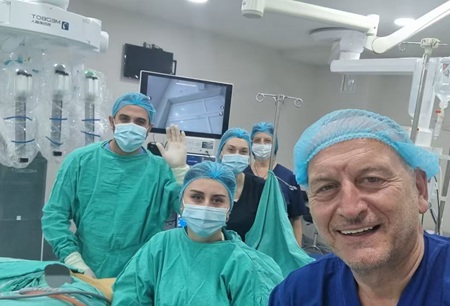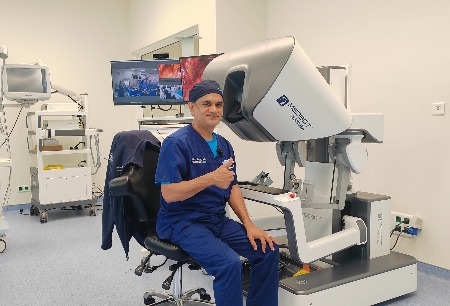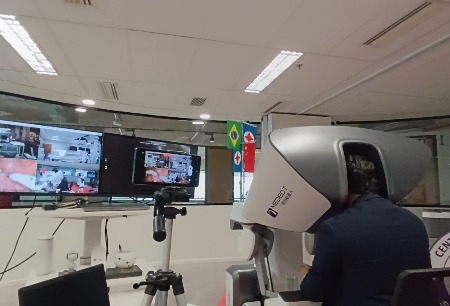Hangzhou, China - On June 18, MicroPort® Toumai® robot successfully completed the world's first ultra-remote 5G robot-assisted hepatectomy, creating a miracle in the history of hepatobiliary surgery in China and even globally. The surgery crossed the territory of 5000 kilometers, connecting the Sir Run Run Shaw Hospital affiliated to the Zhejiang University School of Medicine (hereinafter referred to as "Sir Run Run Shaw Hospital of Zhejiang University") and the Aral Hospital of Sir Run Run Shaw Hospital of Zhejiang University (hereinafter referred to as "Aral Hospital"). It was performed remotely by Xiao Liang, president Xiujun Cai's team of Sir Run Run Shaw Hospital of Zhejiang University, with Zheyong Li, deputy medical director and director of General Surgery Department of Aral Hospital and Yuxin Fan, deputy director of Sir Run Run Shaw Hospital of Zhejiang University, leading the team on site.
This is another pioneering work jointly completed by Xiao Liang, chief physician, and Zheyong Li, vice president following the successful completion of China’s first robot-assisted ultra remote 5G cholecystectomy on February 16 this year.
“The development of new things goes through a process from simplicity to complexity. We have completed the technological leap from remote cholecystectomy to remote liver resection in a very short time, giving us more confidence in challenging more difficult and complex surgical procedures.” Said Xiujun Cai, president of Sir Run Run Shaw Hospital of Zhejiang University who was investigating in Alar.
/ Patient Information /
Patient: gender: female, age: 36 years old, body type: moderately lean.
Medical history: The patient had a history of liver hemangioma for several years and was regularly reviewed by the hospital. This time, due to discomfort in the upper abdomen for several days, she came to the hospital for examination. Vice president Zheyong Li came to the outpatient department to improve the enhanced CT scan of the upper abdomen, and the CT report showed that there were multiple tumors in liver, including three tumors in the S6 segment, which were close to each other. The tumors had a long diameter less than 3 cm. Two of them were located near the liver capsule, with one in the liver parenchyma, and the largest was located in the left lateral lobe of liver, with a long diameter larger than 9 cm, which compressed the gastric cavity.
Considering that the live is a parenchymal organ with dual blood supply, the removal of the hepatic lobe requires extremely meticulous operation to free and accurately transect the blood vessels within the parenchyma. After detailed evaluation and consultation with the multidisciplinary team of Sir Run Run Shaw Hospital of Zhejiang University and Aral Hospital, it was decided that Xiao Liang, chief physician, would perform 5G ultra-remote surgery. Robotic surgery has low bleeding volume, low incidence of postoperative complication and fast recovery. Moreover, Xiao Liang had personally completed hundreds of robotic hepatobiliary and pancreatic operations, and completed the first robot-assisted 5G ultra-remote cholecystectomy in this February with rich experience.
On June 18, with the help of 5G network of telecommunication, Xiao Liang sent surgical instructions to the robotic arm in the operating room in Alar Hospital through the operation console of Chinese-developed MicroPort® Toumai® Surgical Robot, officially performing the surgery. Due to the large hemangioma, Xiao Liang decided to carry out anatomical resection of the left lateral hepatic lobe.
During the surgery, after placing a lens trocar under the patient’s umbilicus, other instrument trocars were placed under direct vision, with a fan-shaped distribution. Xiao Liang operated Toumai robot to open the left hepatic lobe, cut the left triangular ligament of the liver, free the first hepatic portal vein, place a pre-blocking band for exploring the boundary of hemangioma. Because the hemangioma is about 8 cm in size, Xiao Liang decided to carry out anatomical resection of the left lateral hepatic lobe. He blocked the first hepatic portal first, performed resection along the left lateral hepatic lobe, then used EndoCutter to perform auxiliary resection, and clamped the left hepatic vein to transect. After complete transsection of the left lateral hepatic lobe, the blockage was released. Finally, he used a unipolar electric hook to perform wound hemostasis in spray coagulation mode, and placed drainage to take specimens and close the abdomen after confirming no active bleeding.
The surgery was successfully completed within 55 minutes (including 15 minutes of blockage), which achieves a major breakthrough in the world’s first 5G ultra-remote anatomical resection of the left lateral hepatic lobe, and adds another milestone to the development history of 5G remote surgery in China.
According to Xiao Liang, compared with cholecystectomy, hepatectomy is more difficult. The blood vessels and bile ducts in the liver parenchyma are complex, easy to bleed and have biliary fistula, so precise technology is more needed to ensure the safety of surgery. The Chinese-developed Toumai® robot can meet such a requirement. “I didn’t feel any delay in the first 5G ultra-remote robot-assisted cholecystectomy. The operation during the 5G ultra-remote robot-assisted resection of the left lateral hepatic lobe this time was smoother and had a better control effect. Of course, the surgical field was still very clear as always.” Said Xiao Liang. Achieving many “first” shows a major breakthrough in China’s medical field, but also provides a strong proof that China’s 5G technology and Chinese-developed medical equipment technology have already taken the international forefront. At present, Chinese-developed MicroPort® Toumai® four-arm laparoscopic robot and China Telecom 5G network have been used in 3 5G ultra-remote robotic surgeries carried out by Sir Run Run Shaw Hospital of Zhejiang University.
With the arrival of the era of precision medicine, people’s health awareness has significantly improved, and the requirements for diagnosis and treatment effectiveness are also increasing.
Surgical robots can achieve precise control of surgery through precision multi-dimensional vision system, precise surgical arms and control systems, increasing surgical accuracy and safety, and reducing surgical duration and pain. Therefore, it has been widely applied in clinical medicine and is expected to become an important component of medical and health services.
MicroPort® MedBot® always adheres to technological innovation, and its core software and hardware have broken technical barriers to achieve independent research and development. “5G telesurgery technology, the key R&D direction that MicroPort® MedBot® continuously pursue and focus on, is our response to the policy of regional medical community construction under the strategy of "Healthy China", is a favorable way for overcoming physical space restrictions and solving the problems of grassroots medical treatment, and is also a practical practice of MicroPort® MedBot®'s original intention "Make Surgery Easier, Safer and Less Invasive".
Equipped with 5G technology, telesurgery has revolutionary significance for the development of doctors' surgical methods and the medical industry. Namely, patients and doctors do not need to meet, and even at thousands of miles away, they can still see each other in a standard surgical operation room to carry out surgeries, which greatly solves the physical distance barrier for patients and expands the operation space for doctors. As a result, not only does it effectively reduce the hard loss such as transportation and accommodation costs and possible medical delays consumed by patients who seek on-site medical treatment, but it also enables them to contact their doctors remotely anytime and anywhere, satisfying the patients' sense of dependence and psychological needs on the operator. In the long run, it is of great value to widely distribute high-quality medical resources, optimize the distribution of medical resources in each region, and narrow the gap of tiered treatment.
Professor Xiujun Cai pointed out “the market penetration of surgical robots in China is significantly lower than that in the international market. In the future, more and more grassroots hospitals will be equipped with surgical robots. Thanks to the 5G remote technology, we can achieve remote teaching of surgical robots at a lower cost, cultivate reserve talents for local areas, effectively benefiting patients.”
-
 2024-11-18Karazanashvili Robotic Center Completed 100 Toumai® Robot-Assisted Surgeries, becoming the Only Robotic Surgery Center in the Caucasus Region
2024-11-18Karazanashvili Robotic Center Completed 100 Toumai® Robot-Assisted Surgeries, becoming the Only Robotic Surgery Center in the Caucasus Region -
 2024-10-26TOUMAI® SURGICAL ROBOT SYSTEM COMPLETES MULTIPLE LANDMARK ROBOTIC TELESURGERY CASES IN SUB-SAHARA AFRICA IN THE REPUBLIC OF ANGOLA
2024-10-26TOUMAI® SURGICAL ROBOT SYSTEM COMPLETES MULTIPLE LANDMARK ROBOTIC TELESURGERY CASES IN SUB-SAHARA AFRICA IN THE REPUBLIC OF ANGOLA -
 2024-10-26Toumai® Achieves South America's First Tele-Surgery Demonstration
2024-10-26Toumai® Achieves South America's First Tele-Surgery Demonstration






 Hu ICP Bei No. 20013662 HGWA Bei No. 31011502015178
Hu ICP Bei No. 20013662 HGWA Bei No. 31011502015178 " are registered trademarks of Shanghai MicroPort Medical (Group) Co., Ltd.” . They have been authorized to be used by Shanghai Microport Medbot (Group) Co., Ltd., and no other party shall use such trademarks without prior written permission thereof.
" are registered trademarks of Shanghai MicroPort Medical (Group) Co., Ltd.” . They have been authorized to be used by Shanghai Microport Medbot (Group) Co., Ltd., and no other party shall use such trademarks without prior written permission thereof.
